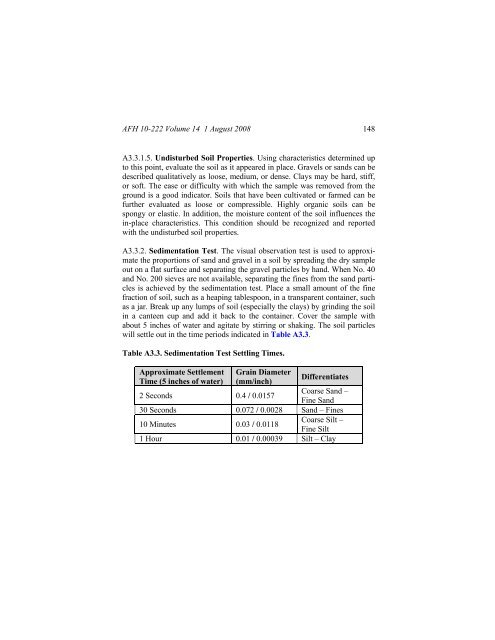Civil engineer guide to fighting positions, shelters, obstacles
Civil engineer guide to fighting positions, shelters, obstacles
Civil engineer guide to fighting positions, shelters, obstacles
You also want an ePaper? Increase the reach of your titles
YUMPU automatically turns print PDFs into web optimized ePapers that Google loves.
AFH 10-222 Volume 14 1 August 2008 148<br />
A3.3.1.5. Undisturbed Soil Properties. Using characteristics determined up<br />
<strong>to</strong> this point, evaluate the soil as it appeared in place. Gravels or sands can be<br />
described qualitatively as loose, medium, or dense. Clays may be hard, stiff,<br />
or soft. The ease or difficulty with which the sample was removed from the<br />
ground is a good indica<strong>to</strong>r. Soils that have been cultivated or farmed can be<br />
further evaluated as loose or compressible. Highly organic soils can be<br />
spongy or elastic. In addition, the moisture content of the soil influences the<br />
in-place characteristics. This condition should be recognized and reported<br />
with the undisturbed soil properties.<br />
A3.3.2. Sedimentation Test. The visual observation test is used <strong>to</strong> approximate<br />
the proportions of sand and gravel in a soil by spreading the dry sample<br />
out on a flat surface and separating the gravel particles by hand. When No. 40<br />
and No. 200 sieves are not available, separating the fines from the sand particles<br />
is achieved by the sedimentation test. Place a small amount of the fine<br />
fraction of soil, such as a heaping tablespoon, in a transparent container, such<br />
as a jar. Break up any lumps of soil (especially the clays) by grinding the soil<br />
in a canteen cup and add it back <strong>to</strong> the container. Cover the sample with<br />
about 5 inches of water and agitate by stirring or shaking. The soil particles<br />
will settle out in the time periods indicated in Table A3.3.<br />
Table A3.3. Sedimentation Test Settling Times.<br />
Approximate Settlement<br />
Time (5 inches of water)<br />
2 Seconds<br />
Grain Diameter<br />
Differentiates<br />
(mm/inch)<br />
Coarse Sand –<br />
0.4 / 0.0157<br />
Fine Sand<br />
0.072 / 0.0028<br />
Coarse Silt –<br />
0.03 / 0.0118<br />
Fine Silt<br />
0.01 / 0.00039<br />
30 Seconds Sand – Fines<br />
10 Minutes<br />
1 Hour Silt – Clay
















